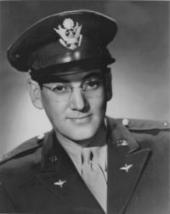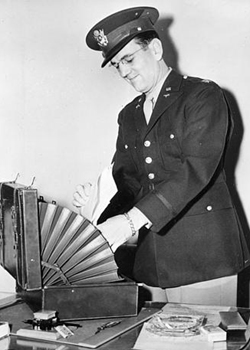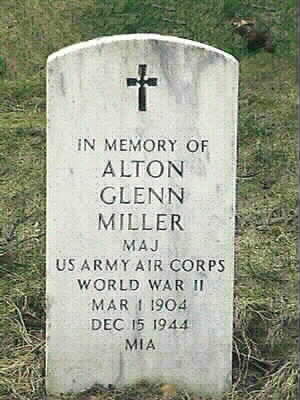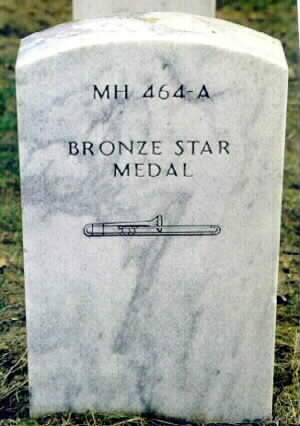Glenn Miller killed by friendly fire, paper says
Big-band leader disappeared in 1944
It has been one of the most enduring ysteries of entertainment history.
On the night of December 15, 1944, U.S. big-band leader Glenn Miller, the hottest pop star of the wartime era, left an airbase in southeast England to entertain U.S. soldiers in Paris.
Within minutes, his plane had disappeared in fog and Mr. Miller was never seen again.
Wild theories about his demise sprang up — from his torture and death at the hands of the Nazis to the less respectful rumour that he had died in the arms of a Paris prostitute and it had all been hushed up.
But a documentary to be shown on British television claims to have unravelled the mystery: Mr. Miller was a victim of friendly fire, a hail of British bombs blowing his tiny single-engined Noorduyn Norseman plane out of the sky, the Guardian newspaper reports today. Documentary-makers believe that a fleet of 139 Lancaster bombers returning on the fateful night from an abortive mission over Nazi Germany dumped their payload into the English Channel — and right on to Mr. Miller’s plane.
In a recently uncovered amateur film interview, Fred Shaw, a navigator on one of the
Lancasters, said he saw the bombs hit a small plane beneath him, the paper said.
“I had never seen a bombing before so I crawled from my navigator seat and put my head in the observation blister. I saw a small high-wing monoplane, a Noorduyn Norseman, underneath,” Mr. Shaw reportedly said in the interview recorded before his death several years ago.
“‘There’s a kite down there,’ I told the rear-gunner. ‘There’s a kite gone in.’ He said ‘Yes, I saw it.’ ”
Mr. Shaw did not make the connection with Mr. Miller until 1956 when he saw the film The Glenn Miller Story.
But with several unanswered questions remaining, his claims were dismissed at the time as publicity seeking.
However, the paper said new research into Mr. Miller’s flight path and time had left little room for doubt.
Mr. Miller and his band became famous for such tunes as Tuxedo Junction, In the Mood, Moonlight Serenade and the million-selling Chattanooga Choo Choo.
The documentary is to be screened on Britain’s Channel Four on New Year’s Eve.
Courtesy of Down Beat Magazine:
Trombonist, arranger and band leader, Glenn Miller became the most popular figure of the swing era; and his music has forever evoked the sense and spirit of American life just before and during World War II. The Miller band offered ballads played in the richly romantic signature sound of four saxes led by a single, pristine
clarinet; and it could perform hard-driving jazz that swung with both precision and energy. In 1940, when Down Beat Readers Polls had separate categories for swing bands and sweet bands, Miller placed second behind Benny Goodman in the swing column, and second behind Tommy Dorsey among sweet bands.
Miller was born March 1, 1904, in Clarinda, Iowa, but grew up in Fort Morgan, Colorado, where he began studying trombone. His formal education ended after a brief period at the University of Colorado at Boulder, after which he joined the Ben Pollack orchestra in California in 1924. Over the next decade he worked steadily, first with Pollack (alongside a young Benny Goodman, five years his junior) and Red Nichols; then in a succession of theater and recording bands and radio orchestras as both sideman and arranger. When Goodman broke through in 1935, Miller sat on the sidelines in New York as contractor for the British band leader Ray Noble.
But his ambitions resisted the temptation to stick with the security of studio and contract work. In 1937 he formed the first of several bands that would take him to the top. The first recorded six undistinguished sides for Decca and a few more for Brunswick before folding. Another band materialized in 1938. The clarinet lead
sound was evident the band’s radio theme, “Moonlight Serenade,” which Miller had originally written and arranged for Noble in 1934. In September 1938 the band was signed by Victor for its Bluebird label, and the following spring Miller finally met his breakthrough at a swank Long Island dance venue called Glen Island Casino.
Miller’s rise was swift through the final months of 1939, and the band went into 1940 with its biggest hit so far, the swing anthem “In The Mood.” Jerry Grey became a prominent arranger/composer swing originals like “Pennsylvania 6-5000,” but the more characteristic Miller ballads, with some exceptions, came to be done more and more to a format that wove the Miller reed together with soft muted brass and trombones colored with brass hat and plunger manipulations.
In the fall of 1942, after making two of the best band films or the era (Sun Valley Serenade and Orchestra Wives), Miller gave up the most popular civilian band in America and offered his services to the war effort. In the Army Air Force, his first assignments involved little more than standard military needs. But Miller pressed to expand his role and after several short details in various bases. He finally ended up with direct responsibility for the band of the Technical Training Command at Yale University, a unit for which Miller hand picked some of the best players coming into the service from the big swing bands, including Ray McKinley and Mel Powell.
In June 1944 the entire Miller operation was shipped to England, where from its base in Bedford it worked a grueling schedule of daily dances, concerts, broadcasts and recording sessions. After the liberation of France, Miller was set to transfer to Paris. The band arrived in December for a Christmas broadcast, but Miller himself
was lost in a small plane over the Channel on December 15.
The band continued its performances until deactivated late in 1945. After the war, other bands played in the Miller style. In 1957 the Miller estate authorized the reformation of the Glenn Miller Orchestra, to be directed by Ray McKinley. It would be the first in a growing list of “ghost bands,” and continues to this day. In 1954, Miller was elected by the Readers into the Down Beat Hall of Fame, in part as a result of the tremendous surge of fresh interest in his music generated by success of The Glenn Miller Story that year.
Major Glenn Miller earned the following awards: Bronze Star Medal, World War II Victory Medal, American Campaign Medal, European, African and Middle Eastern Campaign Medal; Marksman Badge with Carbine and Pistol Bars.
BRONZE STAR MEDAL CITATION:
“Major Alton Glenn Miller (Army Serial No. 0505273), Air Corps, United States Army, for meritorious service in connection with military operations as Commander of the Army Air Force Band (Special), from 9 July 1944 to 15 December 1944. Major Miller, through excellent judgment and professional skill, conspicuously blended the abilities of the outstanding musicians, comprising the group, into a harmonious orchestra whose noteworthy contribution to the morale of the armed forces has been little less than sensational. Major Miller constantly sought to increase the services rendered by his organization, and it was through him that the band was ordered to Paris to give this excellent entertainment to as many troops as possible. His superior accomplishments are highly commendable and reflect the highest credit upon himself and the armed forces of the United States.”
Miller was eligible for a memorial headstone in Arlington National Cemetery as a service member who died on active duty whose remains were not recoverable. At his daughter’s request, a stone was placed in Memorial Section H, Number 464-A on Wilson Drive in Arlington National Cemetery in April 1992.



Michael Robert Patterson was born in Arlington and is the son of a former officer of the US Army. So it was no wonder that sooner or later his interests drew him to American history and especially to American military history. Many of his articles can be found on renowned portals like the New York Times, Washingtonpost or Wikipedia.
Reviewed by: Michael Howard

